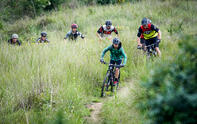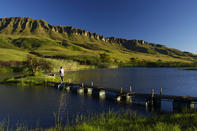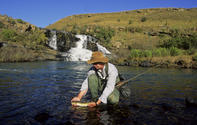Mountain Biking
The mountain bike trail in the Kamberg Nature Reserve is an easy to navigate 13.2 km return route on dirt road and dual track. The is a permit required and fee payable, but there is no map available. The grading is intermediate.

There are plenty of mountain biking trails to choose from in the area. Kick off from the Kamberg Nature Reserve campsite, mountain bike downhill from the cottages along a cement dual track descending towards the trout dams. Turn left onto a very short section of tarmac and onto the jeep track, ignoring the ‘No Entry’ sign for vehicles.
A gritty little climb through a drift and into the grassy foothills follows. Keep right at the 3.9 km mark, heading onto a juddery dual track, dipping and climbing amid the grassland ridges. Expect a few steep climbs and descents, as well as a stream crossing or two. A tight dual track will descend steeply towards the Mooi River before heading back to camp. Glengarry also offers some excellent singletrack trails, combining up to 60 km across local farms.
Hiking Trails

The hiking trails at Kamberg are quite gentle, involving no steep climbs or scrambles. The 4 km Mooi River Trail is a tranquil amble past willows and eucalyptus trees along the banks of the Mooi River, including a 1.5 km section accessible to wheelchairs. There is a booklet of the hikes at reception, including routes to the Emaweni Falls, the Kranse, the Game Shelter and also the Gladstone’s Nose hike, arguably the most scenic hike in the reserve.
At 2 265 m above sea level, Gladstone’s Nose is the highest point in the reserve. This easy day trail passes through grassland and indigenous forests, offering great views of the Giant’s Castle Mountains as well as the valleys running up to the Giant. You’ll start off along a gently climbing and well-worn path before hitting a somewhat steeper section up to the rocky outcrop of Gladstone’s Nose. Enjoy the views and study the changing wind and water-scarred rocks and cliffs before turning back for a gentle freewheel home.
The annual Kamberg Outdoor Challenge is a highlight for many locals in the Kamberg and Midlands area. The fundraiser was conceptualised by Rowan Van Aardt, Simon March and Brad Price and sees contestants take part in a series of outdoor events that are designed to test the perseverance and determination of every team. The whole community comes together to organise the event, and it’s usually a fun-filled, active day that raises funds for the Kamberg Farmers Association.
Brilliant Fly-Fishing Opportunities

Excellent trout waters abound in the vicinity, offering brilliant fly-fishing opportunities in pristine streams as well as in well-stocked dams. The many crystal-clear rivers and dams harbour both brown and rainbow trout of a good size and both put up a good fight. In addition to fly-fishing for trout, bass and carp fishing is found throughout the region.
The Kamberg Nature Reserve straddles the upper Mooi River, offering approximately 13 km of riverfront fishing. There are also six dams in which you can test your skills against these wily trout; fishing in the Eland and Erskine dams is allowed all year round. Eland Dam is very well stocked, while Erskine hides some nice big fellows. Remember to get a day permit at reception before fishing.
More excellent spots close by include a 2 km Mooi River stretch at Glengarry and another 5km stretch on the farm Riverside, which also has four dams. Close to Kamberg you’ll also find the trophy trout fishing dams of Highmoor which must be booked in advance.
The Annual Kamberg Trout Festival, hosted by the Kamberg Farmers’ Association and Bell’s Whisky, is regarded as South Africa’s premier trout-fishing event. The first trout festival was held in 1995 and set a high standard for the years to follow. After more than two decades, the festival is still a popular tourist attraction and brings people from all over South Africa together for a fun three days of fishing and enjoying good food and conversation.